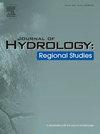Characteristics of the spatiotemporal differences in snowmelt phenology in the Northern Hemisphere
IF 4.7
2区 地球科学
Q1 WATER RESOURCES
引用次数: 0
Abstract
Study region
The Northern Hemisphere.
Study focus
Snowmelt processes are critical components of the hydrological cycle, significantly influenced by climate change. This study analyzes spring-summer snowmelt phenology and rates (1991–2022) using ERA5-Land data, focusing on spatiotemporal trends in snowmelt duration, rate heterogeneity, and drivers under climate change.
New hydrological insights for the region
The snowmelt period length (LSMD) shortens significantly (−0.129 day/year), notably in mid-high latitude North America and temperate Eurasia, while permanent snow zones show prolonged LSMD from intensified ablation. Snowmelt rates exhibit marked spatial heterogeneity: latitude-dependent dynamics peak in temperate-subarctic transition zones (55°-65°N), altitude-driven rates decline below 2800 m but rebound above 3400 m, and longitudinal patterns highlight higher rates in high-longitude regions. Maritime (MT) undergoes the most rapid and prolonged melting, contrasting with slower rates in forested/agricultural areas due to vegetation interactions. Dominantly low-intensity snowmelt prevails, yet transitions to higher intensities are pronounced at 45°-60°N. Regional “mean-extreme decoupling” implies deep snowpack energy storage-release mechanisms. These findings reveal complex, spatially divergent snowmelt responses to warming, critical for predicting hydrological and water resource impacts across the hemisphere.
北半球融雪物候的时空差异特征
研究区域:北半球。融雪过程是水文循环的重要组成部分,受到气候变化的显著影响。利用ERA5-Land数据分析了1991-2022年春夏融雪物候和速率,重点研究了气候变化下融雪持续时间、速率异质性和驱动因素的时空变化趋势。融雪期长度(LSMD)显著缩短(- 0.129 d /年),特别是在北美中高纬度地区和温带欧亚大陆地区,而永久雪区的LSMD则因消融加剧而延长。融雪速率表现出明显的空间异质性:纬度相关的动态变化在温带-亚北极过渡带(55°-65°N)达到峰值,海拔驱动的融雪速率在2800 m以下下降,但在3400 m以上反弹,在纵向模式中,高经度区域的融雪速率更高。由于植被的相互作用,海洋(MT)的融化速度最快,时间最长,而森林/农业地区的融化速度较慢。以低强度融雪为主,但在北纬45°-60°明显过渡到高强度融雪。区域“均值-极值解耦”暗示深层积雪能量储存释放机制。这些发现揭示了气候变暖对融雪的复杂、空间差异的响应,这对预测整个半球的水文和水资源影响至关重要。
本文章由计算机程序翻译,如有差异,请以英文原文为准。
求助全文
约1分钟内获得全文
求助全文
来源期刊

Journal of Hydrology-Regional Studies
Earth and Planetary Sciences-Earth and Planetary Sciences (miscellaneous)
CiteScore
6.70
自引率
8.50%
发文量
284
审稿时长
60 days
期刊介绍:
Journal of Hydrology: Regional Studies publishes original research papers enhancing the science of hydrology and aiming at region-specific problems, past and future conditions, analysis, review and solutions. The journal particularly welcomes research papers that deliver new insights into region-specific hydrological processes and responses to changing conditions, as well as contributions that incorporate interdisciplinarity and translational science.
 求助内容:
求助内容: 应助结果提醒方式:
应助结果提醒方式:


